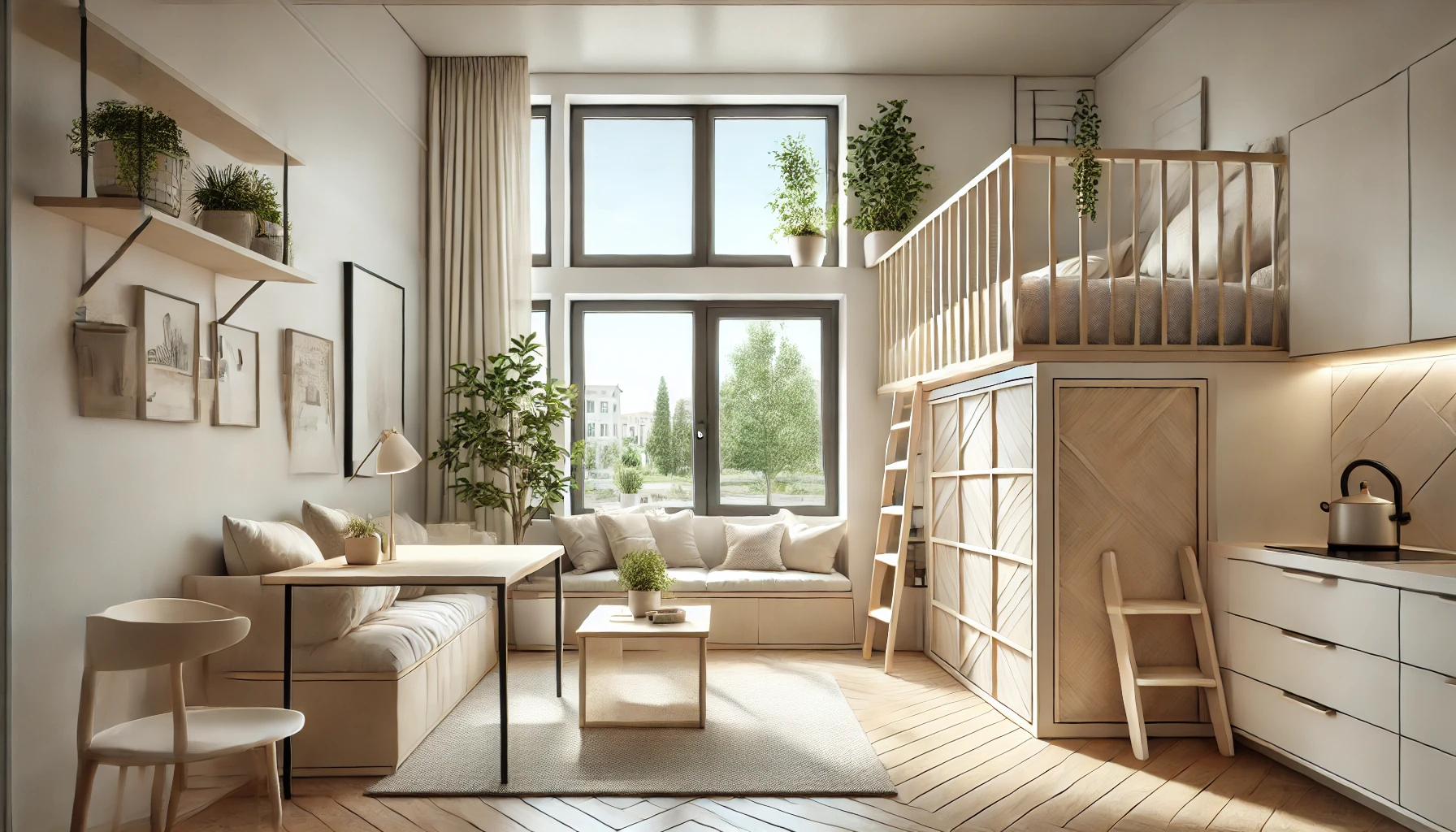Have you ever stepped into a small home that feels cramped, cluttered, and anything but welcoming? Tiny living spaces can be challenging, leaving you wishing for more breathing room and a better sense of comfort.
The problem isn’t just the square footage—it’s how that space is used. Without a strategic approach, your small home can feel like you’re living inside a shoebox. Everything seems to get in the way: furniture feels oversized, storage options seem limited, and natural light never quite reaches those dark corners. It’s enough to make you think that real comfort simply isn’t possible in a smaller abode.
But here’s the good news: with the right design strategies, even the tiniest homes can feel surprisingly spacious, functional, and luxurious. Below, we’ll share five must-see small home designs that prove you don’t need a huge footprint to live large. From clever storage solutions to layout tricks borrowed from top designers, these homes show you exactly how to turn limited space into limitless potential.
Before we dive into these inspiring designs, here are the 3 biggest benefits of implementing these ideas in your own home:
- Optimized Space: Make every inch count and eliminate wasted areas.
- Improved Comfort: Enjoy a home that feels open, airy, and welcoming.
- Increased Style: Enhance your décor to reflect a sophisticated, organized aesthetic.
Now, let’s discover these five must-see designs and explore how you can apply their secrets to your own tiny home.
1. The Open-Concept Marvel
One of the best ways to create a sense of spaciousness is to remove unnecessary barriers. An open-concept layout helps small homes feel larger by blending living, dining, and kitchen spaces into one harmonious area. No walls mean more light flow and sightlines that stretch further, giving the illusion of roominess.
To further enhance this design, consider installing multi-functional furniture that can serve multiple purposes, like a dining table that doubles as a desk or a sofa with hidden storage compartments.
“The beauty of open-concept living is in its simplicity—fewer barriers allow more light and a greater sense of freedom.” —Jane Doe, Founder of NookDesign
Curious about more space-saving hacks? Don’t miss our guide on 10 Genius Small Home Design Hacks to Maximize Every Inch! for even more inspiration.
2. The Lofted Retreat
When you can’t build outward, consider building upward. Lofted small home designs leverage vertical space, placing sleeping areas or relaxation zones above the main living area. This approach frees up valuable floor space below, making it easy to incorporate cozy seating areas or even a small home office.
Incorporate floating shelves and clever storage solutions within the loft’s structure to keep clutter off the floors. Light, neutral walls and airy textiles ensure that the loft doesn’t feel closed-in.
“In my micro-apartment, the loft bed transformed everything. It literally gave me a whole new room underneath!” —Carlos M., Customer
For additional tips on small space styles, check out Small Space, Big Style: 7 Design Ideas You’ll Love! to discover how to add flair and functionality without overcrowding.
3. The Hidden Storage Haven
In tight quarters, clutter is the enemy. One must-see design involves integrating hidden storage throughout your home. From built-in benches with lift-up lids to stairs that double as storage drawers, these solutions turn every nook and cranny into usable space. Consider installing cabinets that blend seamlessly with walls, concealing everything from clothing to kitchen supplies.
Brighten the space with large mirrors, ensuring your hidden storage solutions are as visually appealing as they are practical. This approach keeps surfaces clear, making your home feel open and inviting.
“My tiny home used to feel crowded, but after adding hidden storage, it’s neat, organized, and feels twice as large!” —Rachel L., Customer
Want more clever storage tricks? Head over to our Transform Your Tiny Home with These 9 Space-Saving Tips! for an in-depth look at maximizing every inch of your living area.
4. The Glass and Light Oasis
Incorporating transparent elements—such as glass doors, walls, or partitions—can work wonders in a small space. Instead of blocking off areas, glass allows light to flow freely while maintaining a clear line of sight. Pair this with abundant natural light from strategically placed windows and skylights to help your home feel bright and expansive.
Opt for light-toned furniture and reflective surfaces like glossy countertops or metallic accents. Even in a small footprint, the combination of glass, mirrors, and natural light gives an airy, modern feel that leaves you breathing easier.
“Light is a powerful design element. When it moves unobstructed through a space, it adds life and depth—even in tiny homes.” —Jane Doe, Founder of NookDesign
For more inspiration on maximizing style, you can browse through our 5 Must-See Small Home Designs That Feel Surprisingly Spacious! (the article you’re currently reading), or discover Small Home Magic: 8 Clever Ideas for a Stylish & Functional Space! to expand your horizons.
5. The Modular Marvel
Another standout small home design emphasizes modular furniture and flexible room arrangements. Picture seating elements that slide into each other, tables that fold up against the wall, and storage units on wheels. This adaptability means you can quickly transform one area of your home into another—today it’s a dining nook, tomorrow it’s a home office.
This design encourages creativity and personalization. By choosing pieces that are easy to rearrange, you’ll never feel stuck with a layout that doesn’t serve your evolving lifestyle.
“Our modular seating and fold-away desk changed everything. We rearrange the space daily based on what we need—versatility at its finest!” —Sharon T., Customer
To learn more about multi-functional furniture and how to choose the perfect piece, visit How to Choose the Perfect Multi-Functional Furniture for Small Homes. You’ll find plenty of insider tips to maximize both style and utility.
Don’t miss out on these trends—thousands have already discovered the joy of living large in a small home. The demand for small-space solutions is rising, and savvy homeowners are quickly learning how these designs improve comfort, style, and well-being. Act now, and you’ll join the ranks of those enjoying homes that feel spacious and sophisticated, despite their modest proportions.
The clock is ticking: as more people adopt these innovative design techniques, the best resources and products may become harder to find. Now is the time to secure your dream home setup before these must-have pieces sell out and the best designers book up months in advance.
Create Your Own Spacious Haven
No matter which of these five designs inspires you most, the key takeaway is that small homes are no longer defined by their size—they’re defined by their creativity, functionality, and style. By applying the principles of open-concept living, lofted retreats, hidden storage, transparent elements, and modular furniture, you can craft a home that truly feels like your personal oasis.
Why wait to experience the transformation? Upgrade your small living space today and see how these must-see designs can make a meaningful impact on your daily life.
Discover space-saving solutions now and turn your tiny home into a spacious haven!
Explore More Inspiring Articles
- 10 Genius Small Home Design Hacks to Maximize Every Inch!
- Small Space, Big Style: 7 Design Ideas You’ll Love!
- Transform Your Tiny Home with These 9 Space-Saving Tips!
- 5 Must-See Small Home Designs That Feel Surprisingly Spacious!
- Small Home Magic: 8 Clever Ideas for a Stylish & Functional Space!
- Clever Storage Solutions: Get Organized in Your Tiny Living Space
- How to Choose the Perfect Multi-Functional Furniture for Small Homes
- Micro-Apartments Done Right: 6 Inspiring Design Examples
- Designing Your Small Home Office: Tips for Productivity and Comfort
- Vertical Living: Smart Hacks for Utilizing Walls and Ceilings


